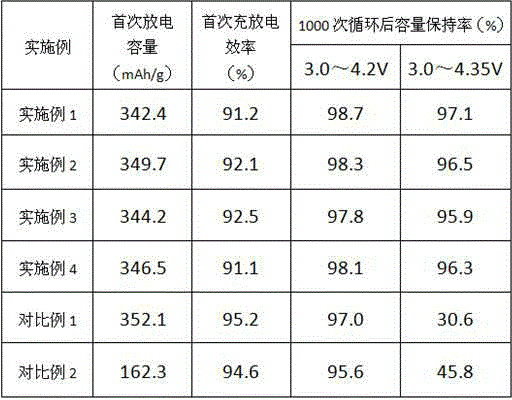Manufacturing method for high-voltage lithium ion anode material
A negative electrode material, lithium ion technology, applied in battery electrodes, circuits, electrical components, etc., can solve the problems of low conductivity of lithium metal oxide, poor rate performance of lithium titanate, low energy density of lithium titanate, etc. The effect of axial one-dimensional conductivity, poor conductivity, and reduced thickness expansion
- Summary
- Abstract
- Description
- Claims
- Application Information
AI Technical Summary
Problems solved by technology
Method used
Image
Examples
Embodiment 1
[0015] The ultrafine graphite accounts for 5% of the total weight of the graphite and the lithium titanate material, and is stirred with lithium titanate to make it fully mixed, and the stirring and mixing time is 3 hours, so that the graphite material is evenly wrapped on the surface of the lithium titanate; then at 1500 ℃ heat treatment for 1 hour, the lithium titanate material is melted and tightly wrapped in the center of the graphite particles, thereby forming a stable graphite coating layer; finally, carbon nanotubes are added in a proportion of 2% of the total weight of the negative electrode material, and the graphite coating The lithium titanate material was ball-milled for 8 hours to obtain a lithium titanate / graphite / conducting agent three-layer negative electrode material.
Embodiment 2
[0017] The ultrafine graphite accounts for 1% of the total weight of the graphite and the lithium titanate material, and is stirred with lithium titanate to make it fully mixed, and the stirring and mixing time is 5 hours, so that the graphite material is evenly wrapped on the surface of the lithium titanate; then at 1800 Heat treatment at ℃ for 1 hour to melt the lithium titanate material and tightly wrap it in the center of the graphite particles, thereby forming a stable graphite coating layer; finally, add vapor-grown carbon fibers in the proportion of 1% of the total weight of the negative electrode material, and the graphite coating The lithium titanate material was ball-milled for 24 hours to obtain a lithium titanate / graphite / conducting agent three-layer negative electrode material.
Embodiment 3
[0019] The ultrafine graphite accounts for 10% of the total weight of graphite and lithium titanate material, and is stirred with lithium titanate to make it fully mixed, and the stirring and mixing time is 5 hours, so that the graphite material is evenly wrapped on the surface of lithium titanate; then at 1600 ℃ heat treatment for 1 hour, the lithium titanate material is melted and tightly wrapped in the center of the graphite particles, thereby forming a stable graphite coating layer; finally, carbon nanotubes are added in a proportion of 5% of the total weight of the negative electrode material, and the graphite coating The lithium titanate material was ball-milled for 20 hours to obtain a lithium titanate / graphite / conducting agent three-layer negative electrode material.
PUM
| Property | Measurement | Unit |
|---|---|---|
| particle size | aaaaa | aaaaa |
| particle size | aaaaa | aaaaa |
Abstract
Description
Claims
Application Information
 Login to View More
Login to View More - R&D
- Intellectual Property
- Life Sciences
- Materials
- Tech Scout
- Unparalleled Data Quality
- Higher Quality Content
- 60% Fewer Hallucinations
Browse by: Latest US Patents, China's latest patents, Technical Efficacy Thesaurus, Application Domain, Technology Topic, Popular Technical Reports.
© 2025 PatSnap. All rights reserved.Legal|Privacy policy|Modern Slavery Act Transparency Statement|Sitemap|About US| Contact US: help@patsnap.com

